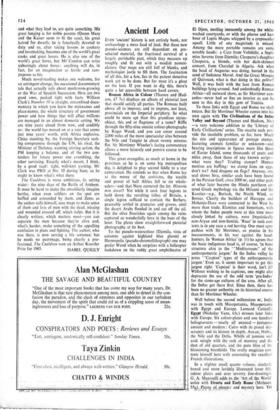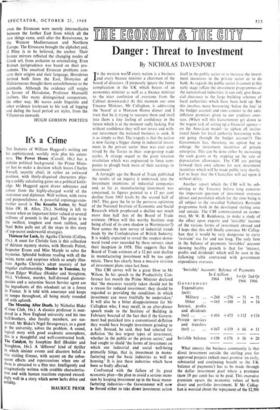Ancient Loot Every 'ancient' history is not entirely bunk, nor
archaeology a mere load of junk. But these new pseudo-sciences are still dependent on pre- selected material, the fractional survival of a largely perishable past, which they measure up roughly and fit out with a modish nomen- clature. Our maps are still full of blanks, and mythologies jostle to fill them. The fascination of all this, for a few, lies in the patient detective work yet to be done. But for most it's a gloat on the loot. If you want to dig this, there's quite a lot accessible between hard covers.
Roman Africa in Colour (Thames and Hud- son, £7 7s.) displays an album of pictorial loot that should satisfy all parties. The Romans built above all to impress; and to impress, not least, provincials on the Imperial periphery. So what could be more apt than this grandiose status- object, this sod or flagstone of a tome? Riffle through the fifty-nine outsize colour-photographs by Roger Wood, and you can cover around 2,000 miles of the more spectacular sites between the Nile and Tangier in about twenty minutes flat. Sir Mortimer Wheeler's facing commentary allows a more leisurely and pensive course to be followed.
This great evangelist, as much at home in the provinces as he is on some big metropolitan dig, is delighted to play second fiddle to a star cameraman. He reminds us that when Rome lay at the mercy of the arrivistes, the wealth and power of. half Africa fell to six whole- salers—and that Nero cornered the lot. Historia non docet? Yet while it took four legions to hold down the revolting tribes of Britain, a single legion sufficed to contain the Berbers, peaceably settled in granaries and -groves, until the desert Arabs flooded in and cut off the oil. But the olive flourishes again among the ruins captured so wonderfully here in the hues of the hour. The plates show straightforward pictorial photography at its best.
To the pseudo-watercolour (Djemila, vista of columns against highland blue gloom) or Hermopolis (pseudo-chromolithograph) one may prefer Wood when he surprises with a helicopter lookdown on the ruddy great amphitheatre of El Diem, nestling innocently among the white- washed courtyards, or with the Pharos and har- bour of Leptis Magna whipped by a crepuscular squall. Little of any magnitude is missed. Among the more portable remains are some notable heads : a Cato from Volubilis; a Septi- mius Severus from Djemila; Cleopatra's daughter Cleopatra, a blonde, with her dark-skinned consort, from Cherchel in Algeria. Ask what the head of Augustus was doing, buried in the sand of Sudanese Meroe. And the Great Mosque of Qairouan, what is that doing in this galere? Well, it was built with the loot from Roman buildings lying around. And undoubtedly Roman Africa—all outward show, as Sir Mortimer con- cedes—never had so fine an interior as can be seen to this day in this gem of Tunisia.
To these links with Egypt and Rome we shall return. But Sir Mortimer Wheeler comes into his own again with The Civilisations of the Indus Valley and Beyond (Thames and Hudson, 30s.) —a very welcome addition to the 'Library of Early Civilisations' series. The steatite seals pro- vide the insoluble problem, so far, here. Much the size and appearance of postage stamps. featuring animals familiar or unknown—and bearing inscriptions in figures more like those of Easter Island, some thousands of years and miles away, than those of any known script— what were they? Trading stamps? Human motives are baffling: we stamp lions on eggs, don't we? And dragons on flags? Anyway, one seal shows Siva, similar seals have been found in the Persian Gulf, circa 2000 ix, and other gods of what later became the Hindu pantheon en- tered Greek mythology via the Mitanni and the Kassites—e.g., Buriash, the North Wind, or Boreas. Clearly the builders of Harappa and Mohenjo-Daro were connected to the West by more than trade. Elamites and Sumerians, with whom the Indus people were at this time most closely linked by culture, were linguistically non-Aryan and non-Semitic. 'Race' in such con- texts is in any case a red herring. One must sym- pathise with Sir Mortimer, so precise in his measurements, in his war against the head- hunters. In 'Roman Africa' (p. 11) he agrees that the basic indigenous head is, of course, 'in bone structure akin to the "Mediterreans" of the anthropometric jargon.' In the Indus valley he notes "'Caspian" types of the anthropometric jargon.' Even so, it seems important to get this jargon right. 'Capsian' is their word, isn't it? Without wishing to be captious, one might also deprecate the use of the odd term 'pre-Indus' for the stone-age cultures of the area. After all, the Indus got there first. Since then, there has been no greater authority on its historical course than Sir Mortimer Wheeler.
Well before the second millennium Be, India was in touch with Mesopotamia, Mesopotamia with Egypt and Europe. Leonard Cottrell's Egypt (Nicholas Vane, 63s.) stresses later links with Europe. Six colour-plates and one hundred heliogravures — nearly all unusual — juxtapose ancient and modern : Cairo with its proud sky- scrapers and its history in depth, Aswan, Nubia, the Nile and the Delta. Whiffs of jasmine and arak mingle with the reek of mummy and the dust of old quarters, and the pure bliss of the blossoming beanfields. The crafty magician con- tents himself here with annotating the excellent French illustrations.
fn a slig-hter small. quarto volume, similarly boxed and more lavishly illustrated (over fift, colour plates and over seventy line-drawings). G , A. 144Apsuglii, arlcls 0,44e, 'Art .0#, OW World' series with Etruria and Early Rome (Methuen, 5511tAinq p- pluilrler and mystery here. Yet even the Etruscans were merely intermediaries between the farther East from which all the new things came, until after the Renaissance, to the Western Mediterranean and Northern Europe. The Etruscans brought the alphabet and, if Pliny is to be believed, the anchor. Their bronze mirrors reflected the changing modes of Greek art, from archaism to orientalising. Even Roman jurisprudence was based on their pre- cedents. The unsolved Etruscan problems con- cern their origins and their language. Herodotus derived both from the East, Dionysius of Halicarnassus thought them autochthonous to the peninsula. Although the evidence still weighs in favour of Herodotus, Professor Mansuelli inclines, like many distinguished compatriots, the other way. He waves aside linguistic and other evidence irrelevant to his task of logging and dating the local period art styles, from the Villanovan onwards.
HUGH GORDON PORTEUS



































 Previous page
Previous page